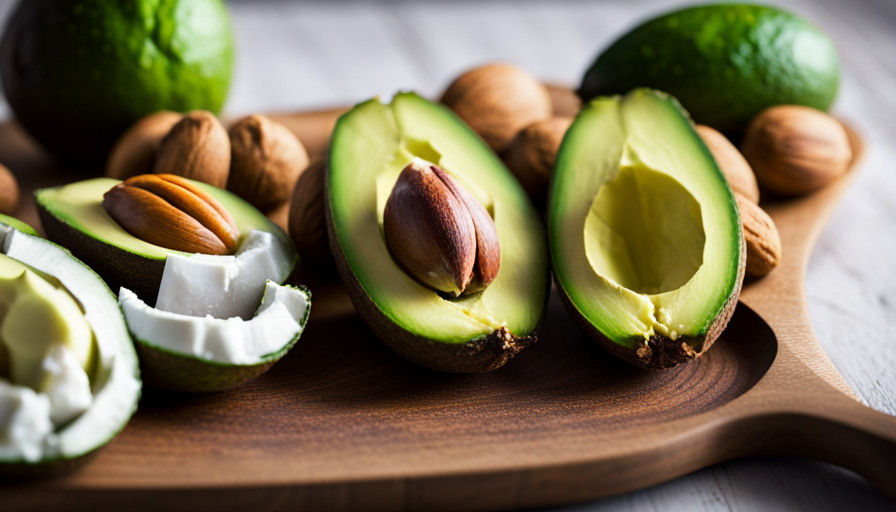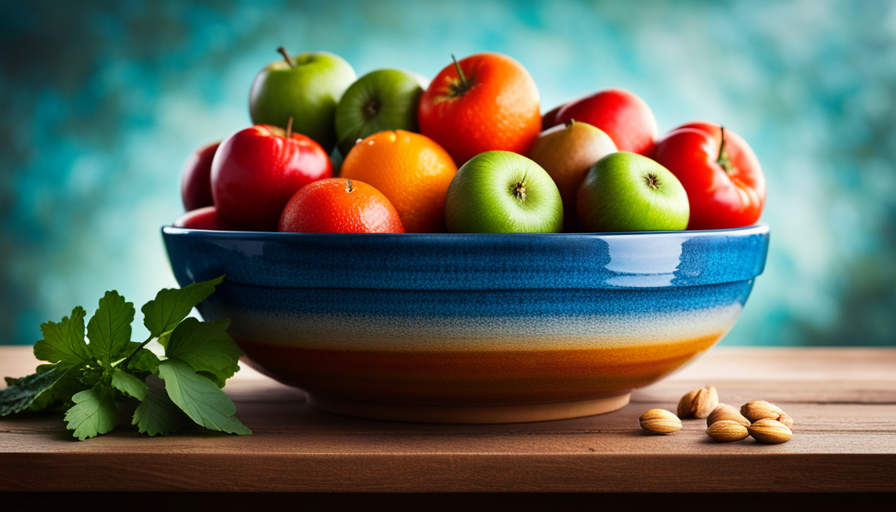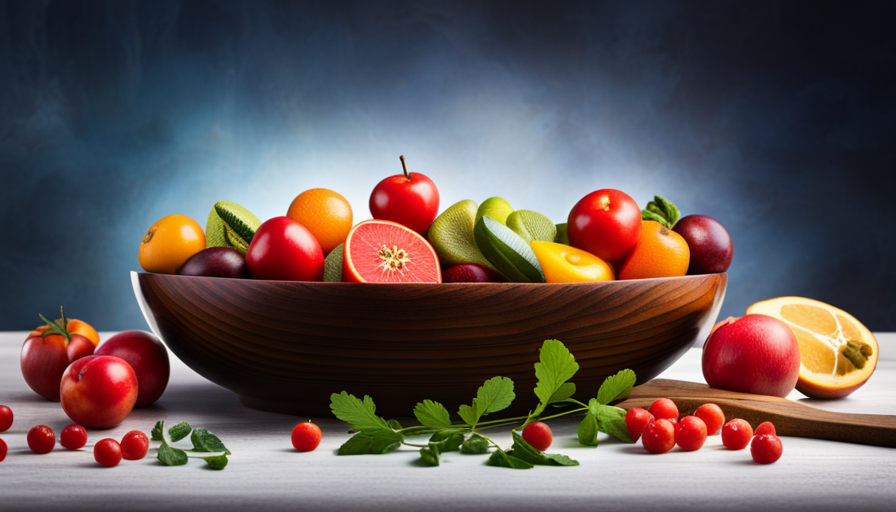If you are following a raw food diet and struggling to incorporate enough fats into your meals and snacks, I am here to help! I will guide you through the maze of healthy fats to ensure that your raw food journey is filled with the nourishment your body needs.
Fats are a crucial component of a balanced diet, providing energy, supporting hormone production, and aiding in nutrient absorption. But on a raw food diet, where cooking oils and fatty meats are off the table, it’s important to get creative with your fat sources.
Incorporating avocados, nuts, seeds, coconut products, and cold-pressed oils can help boost your fat intake while adding delicious flavors and textures to your meals. High-fat fruits, sprouted grains, and legumes can also be valuable additions to your raw food repertoire.
By being mindful of portion sizes and seeking professional guidance, you can ensure you’re meeting your fat requirements and enjoying a sustainable and nutritious raw food diet. So let’s dive into the world of healthy fats and discover how to make them a delicious and essential part of your raw food journey.
Key Takeaways
- Incorporate avocados, nuts, seeds, coconut products, and cold-pressed oils into your raw food diet to ensure sufficient healthy fat intake.
- Include high-fat fruits, sprouted grains, and legumes in your meals to boost fat content and obtain essential nutrients.
- Consume nuts and seeds in moderation due to their calorie density.
- Seek professional guidance from a nutritionist or dietitian to ensure you are meeting your individual dietary needs and obtaining enough fat on a raw food diet.
Understand the Importance of Healthy Fats in a Raw Food Diet
You need to understand the importance of healthy fats in a raw food diet because they’re the secret to glowing skin and strong, shiny hair! Healthy fats play a crucial role in our overall health and well-being. They provide energy, support brain function, promote hormone production, and aid in the absorption of fat-soluble vitamins.
One important component of healthy fats are essential fatty acids (EFAs), which our bodies cannot produce on their own and must be obtained through diet. EFAs, such as omega-3 and omega-6, are crucial for brain development, reducing inflammation, and supporting heart health. In a raw food diet, it’s essential to ensure an adequate intake of these EFAs to maintain optimal health.
To incorporate avocados into your meals, which are a great source of healthy fats, you can enjoy them in various ways. Add sliced avocados to salads, blend them into creamy dressings, or use them as a spread on raw crackers or bread. Avocado is not only rich in healthy fats but also provides important nutrients like fiber, vitamins, and minerals.
Understanding the importance of healthy fats and incorporating foods like avocados into your raw food diet will help you achieve a balanced intake of essential nutrients and support your overall health and well-being.
Incorporate Avocados into Your Meals
Incorporating avocados into meals adds depth and complexity to your raw food regimen. Avocados are not only delicious, but they are also packed with healthy fats that are essential for a balanced raw food diet. They are rich in monounsaturated fats, which can help improve heart health and reduce inflammation in the body. Additionally, avocados are a great source of vitamins and minerals, including vitamin K, vitamin E, vitamin C, and potassium.
To give you an idea of how versatile avocados can be in your raw food meals, here are a few avocado recipes to try:
| Breakfast | Lunch | Snack | Dinner |
|---|---|---|---|
| Avocado smoothie | Avocado salad | Avocado cucumber | Avocado sushi |
| rolls | |||
| Avocado lettuce | |||
| wraps |
These recipes not only provide a delicious way to incorporate avocados into your raw food diet, but they also offer a variety of flavors and textures.
By incorporating avocados into your meals, you can easily boost your fat intake and ensure you are getting enough healthy fats on a raw food diet. However, avocados are not the only source of fats for a raw food diet. In the next section, we will explore how adding nuts and seeds can further enhance your fat intake.
Add Nuts and Seeds to Boost Your Fat Intake
To amp up your fat intake on a raw food plan, why not sprinkle some nuts and seeds into your meals? Nuts and seeds are excellent sources of healthy fats and can easily be incorporated into a raw food diet. They provide a variety of essential nutrients, including omega-3 fatty acids, vitamin E, and protein. Adding a handful of walnuts, almonds, chia seeds, or flaxseeds to your salads, smoothies, or raw desserts can help you meet your fat requirements while enjoying a delicious meal.
When incorporating nuts and seeds into your raw food diet, it’s important to find the right balance of fats. While they’re nutritious, they’re also calorie-dense, so it’s crucial to consume them in moderation. Aim to include a variety of different nuts and seeds in your meals to obtain a wide range of nutrients and flavors.
In addition to providing healthy fats, nuts and seeds also contribute to a feeling of satiety, which can help prevent overeating and promote weight management. They add a satisfying crunch and texture to your dishes, making them more enjoyable and satisfying.
Next, let’s explore how to include coconut products in your recipes to further enhance your fat intake on a raw food diet.
Include Coconut Products in Your Recipes
Indulging in the creamy richness of coconut products will transport your taste buds to a tropical paradise, infusing your dishes with a luscious burst of flavor that’s like sipping a piña colada on a sun-drenched beach. Coconut products are not only delicious but also a great source of healthy fats, which are essential for a balanced raw food diet.
Here are some ways to include coconut products in your recipes:
- Coconut milk: Use it as a base for smoothies, soups, or sauces.
- Coconut oil: Substitute it for other oils in cooking or baking.
- Coconut butter: Spread it on raw crackers or use it as a frosting for desserts.
- Coconut flakes: Sprinkle them on top of salads or incorporate them into raw granola.
- Coconut water: Enjoy it as a refreshing drink or use it as a base for smoothies.
These coconut products not only provide a creamy texture and tropical flavor but also offer a rich source of healthy fats that are beneficial for your body. By incorporating them into your raw food recipes, you can easily meet your fat requirements while enjoying a variety of delicious dishes.
Next, let’s explore the importance of using cold-pressed oils in moderation.
Use Cold-Pressed Oils in Moderation
Utilizing cold-pressed oils in moderation adds a subtle touch of indulgence to your dishes without overwhelming them. When following a raw food diet, it’s important to find the right balance of fats to maintain optimal health. Cold-pressed oils, such as olive oil, avocado oil, and flaxseed oil, can be excellent sources of healthy fats.
To help you incorporate cold-pressed oils into your raw food recipes, here is a table outlining some alternatives and their nutritional profiles:
| Cold-Pressed Oil | Fat Content per 1 tbsp | Omega-3 Fatty Acids | Omega-6 Fatty Acids |
|---|---|---|---|
| Olive oil | 14g | 1.9g | 10.1g |
| Avocado oil | 14g | 0.9g | 9.9g |
| Flaxseed oil | 14g | 7.3g | 1.6g |
| Walnut oil | 14g | 1.4g | 10.0g |
Finding the right balance of fats is essential for a healthy raw food diet. It’s important to consider your individual requirements and health conditions when incorporating cold-pressed oils. They can be a great addition to dressings, marinades, or drizzled over salads. Remember, moderation is key.
In the next section, we will explore another way to add healthy fats to your raw food diet: experimenting with nut butters and seed spreads.
Experiment with Nut Butters and Seed Spreads
Try incorporating nut butters and seed spreads to add a creamy and nutritious element to your raw recipes. Experimentation with these alternatives can provide a range of benefits.
Nut butters, such as almond or cashew butter, are rich in healthy fats, protein, and fiber. They can be used as a topping for fruit, added to smoothies, or used as a base for sauces and dressings.
Seed spreads, like tahini or sunflower seed butter, offer a similar nutritional profile and can be used in a variety of ways.
When choosing nut butters and seed spreads, opt for those that are minimally processed and free from added sugars or oils. Look for products that are made from 100% nuts or seeds. It’s also important to pay attention to portion sizes, as these spreads can be calorie-dense. Stick to a tablespoon or two per serving to ensure you’re getting enough fat without overdoing it.
Incorporating nut butters and seed spreads into your raw food diet can provide a delicious and convenient way to increase your fat intake. These alternatives offer a wide range of flavors and textures, allowing for plenty of experimentation in the kitchen. By adding these nutrient-dense spreads to your meals and snacks, you can ensure you’re meeting your fat requirements in a sustainable and enjoyable way.
Moving on to the next step, another way to incorporate more healthy fats into your raw food diet is to incorporate high-fat fruits into your meals.
Incorporate High-Fat Fruits into Your Diet
When it comes to getting enough fat on a raw food diet, experimenting with nut butters and seed spreads is a great way to add some healthy fats to your meals. However, there are other delicious options to consider as well.
One way to incorporate more fat into your diet is by including high-fat fruits. These fruits not only provide essential nutrients but also offer a good amount of healthy fats.
Here are three ways you can incorporate high-fat fruits into your meals:
-
Avocado: This creamy fruit is packed with monounsaturated fats, which are known to promote heart health. Add sliced avocado to salads, blend it into smoothies, or use it as a spread on raw crackers.
-
Coconut: Not only does coconut provide healthy fats, but it also adds a tropical flavor to your dishes. You can enjoy coconut meat as a snack, use coconut milk in smoothies or curries, and even sprinkle shredded coconut on top of your raw desserts.
-
Olives: These small fruits are high in healthy fats, particularly monounsaturated fats. Add olives to salads, use them as a topping for raw pizzas, or blend them into dressings for a delicious and nutritious boost.
By incorporating these high-fat fruits into your diet, you can ensure that you’re getting enough fat on a raw food diet while reaping the benefits of these nutritious fruits. Consider adding sprouted grains and legumes to further enhance your raw food journey and boost your nutrient intake.
Consider Adding Sprouted Grains and Legumes
Consider incorporating sprouted grains and legumes into your meals to elevate your raw food journey and maximize your nutrient intake.
Sprouted grains, such as quinoa, buckwheat, and amaranth, are rich in healthy fats and provide a good source of omega-3 fatty acids. These fats are essential for brain health, reducing inflammation, and supporting heart health. Additionally, sprouted grains are packed with fiber, vitamins, and minerals, making them a valuable addition to a raw food diet.
Legumes, like lentils, chickpeas, and black beans, are also an excellent source of healthy fats. They contain monounsaturated and polyunsaturated fats, which can help lower cholesterol levels and reduce the risk of heart disease. Furthermore, legumes are high in protein, fiber, and essential nutrients, making them a great choice for those following a raw food diet.
When incorporating sprouted grains and legumes into your raw food meals, it’s important to consider digestion. Soaking, sprouting, or fermenting these foods can enhance their digestibility and nutrient absorption. These processes help break down anti-nutrients and make the nutrients more bioavailable to your body.
To ensure a well-balanced raw food diet, be mindful of portion sizes and balance. While sprouted grains and legumes are a valuable source of healthy fats, it’s important to include a variety of other fruits, vegetables, nuts, and seeds to meet your overall nutrient needs. Transitioning into the next section, remember to be mindful of portion sizes and balance to optimize your raw food journey.
Be Mindful of Portion Sizes and Balance
When following a raw food diet, it’s important to be mindful of portion sizes and balance to ensure you’re getting enough fat. While adding sprouted grains and legumes can be a great way to increase your fat intake, it’s also important to consider other alternative sources. Mindful eating can play a significant role in ensuring you’re getting enough fat on a raw food diet. By paying attention to your body’s hunger and fullness cues, you can better gauge how much fat you need and avoid overeating. Additionally, incorporating a variety of healthy fats from sources such as avocados, nuts, and seeds can help meet your fat requirements. These foods can be enjoyed in moderation and can add flavor and texture to your meals.
To convey a deeper understanding, consider the following table:
| Food Sources | Healthy Fats |
|---|---|
| Avocado | Monounsaturated fats |
| Walnuts | Omega-3 fatty acids |
| Chia seeds | Omega-3 fatty acids |
| Coconut oil | Medium-chain triglycerides (MCTs) |
Finding alternative sources of fat on a raw food diet is easily achievable by incorporating these foods into your meals. However, it’s important to seek professional guidance and support to ensure you’re meeting all your nutritional needs.
Seek Professional Guidance and Support
If you’re embarking on a raw food journey, it’s essential to seek the guidance and support of a professional to ensure you’re on the right track and maximizing your potential for success. A nutritionist or registered dietitian would provide accurate and evidence-based information to help you meet your dietary needs, including obtaining enough fat on a raw food diet.
A nutritionist or registered dietitian would take a holistic approach to nutrition, considering all aspects of your dietary needs. They would provide information on obtaining a balanced intake of nutrients, including fats, while also taking into account your individual requirements and health conditions. This personalized approach ensures that you are getting the right amount of fat for your body.
In terms of practical advice, a nutritionist or registered dietitian would offer specific strategies and suggestions to help you meet your fat requirements in a sustainable and enjoyable way. They may recommend incorporating healthy sources of fat such as avocados, nuts, and seeds into your meals and snacks. They may also provide tips on portion sizes and meal planning to ensure you are getting enough fat throughout the day.
By seeking professional advice, you can ensure that you are meeting your dietary needs on a raw food diet, including obtaining enough fat. A nutritionist or registered dietitian can provide you with the knowledge and support you need to thrive on your raw food journey.
Frequently Asked Questions
Can I still get enough fat on a raw food diet if I don’t like avocados?
If you don’t like avocados, there are still plenty of fat alternatives you can incorporate into your raw food diet. Try adding nuts and seeds like almonds, walnuts, chia seeds, and flaxseeds. These foods are rich in healthy fats and can be easily incorporated into your meals.
You can also include coconut products like coconut oil or coconut meat. These options will help you meet your fat requirements while enjoying a varied and nutritious raw food diet.
Are there any raw food-friendly alternatives to nuts and seeds for getting enough fat?
If you’re looking for alternative fat sources on a raw food diet, there are a few options to consider. One option is coconut, which is high in healthy fats and can be consumed fresh or as coconut oil.
Another option is olives, which are rich in monounsaturated fats.
Additionally, you can incorporate flaxseeds and chia seeds into your diet, as they’re excellent sources of omega-3 fatty acids.
These alternative fat sources can provide the benefits of a high-fat raw food diet while offering variety in your meals.
How can I incorporate coconut products into my recipes if I don’t like the taste of coconut?
To incorporate coconut products into your recipes without the taste of coconut, you can try using refined coconut oil instead of virgin coconut oil. Refined coconut oil has a milder taste and aroma.
Additionally, you can use coconut milk or cream in your recipes, as they provide a creamy texture without an overpowering coconut flavor.
Coconut products can also be beneficial for your skin and hair, as they contain moisturizing and nourishing properties.
Can I use any type of oil in moderation, or are there specific oils that are better for a raw food diet?
Using oils in moderation on a raw food diet can be a great way to incorporate healthy fats into your meals. While any type of oil can be used in moderation, it’s important to choose the best oils for a raw food diet.
Cold-pressed oils, such as extra virgin olive oil and avocado oil, retain more nutrients and are less processed. These oils also provide a good balance of omega-3 and omega-6 fatty acids, which are essential for optimal health.
Are there any high-fat fruits that are more beneficial for getting enough fat on a raw food diet than others?
High-fat fruits, such as avocados, coconuts, and olives, can be beneficial for getting enough fat on a raw food diet. These fruits provide a good source of healthy fats, including monounsaturated and polyunsaturated fats, which are essential for various bodily functions. Incorporating these high-fat fruits into your diet can help promote satiety, support brain health, and provide energy.
However, it’s important to remember that a balanced and comprehensive approach to nutrition is key, considering individual requirements and health conditions.
Do Raw Food Diets Provide Enough Fat and Calories for a Healthy Lifestyle?
Some people worry about getting enough calories on a raw diet, but it is possible to maintain a healthy lifestyle. Raw nuts, seeds, avocados, and coconut oil are great sources of healthy fats and calories. It’s essential to carefully plan your meals to ensure you’re getting enough calories raw diet.
Conclusion
In conclusion, it’s crucial to incorporate enough healthy fats into a raw food diet for overall health and well-being. By including avocados, nuts, seeds, coconut products, and high-fat fruits, you can ensure an adequate intake of fats.
Remember to use cold-pressed oils in moderation and consider adding sprouted grains and legumes for additional fat sources. It’s important to be mindful of portion sizes and seek professional guidance to ensure a balanced and comprehensive approach to your raw food diet.
By following these practical and actionable strategies, you can enjoy a nutritious and satisfying raw food lifestyle. So go ahead, nourish your body and thrive on your raw food journey.










